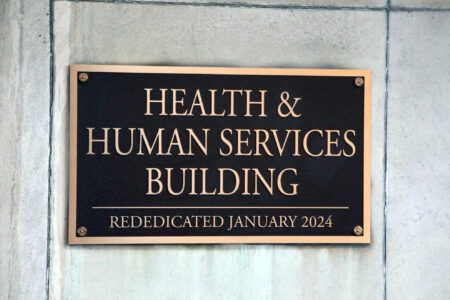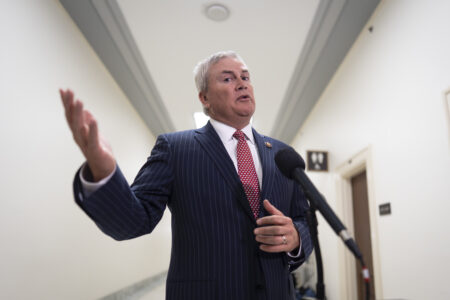When hospitals buy physician practices, prices go up
Less than half of U.S. physicians still work in a physician-owned private practice

Photo by Spencer Platt/Getty Images via Penn Capital-Star A medical worker walks by an entrance to Elmhurst Hospital Center, on May 11, 2023 in the Queens Borough of New York City.
As more hospitals have gobbled up private physician practices, costs for childbirth and other services have gone up, according to a new study.
Since the early aughts, the share of physicians in the United States working for hospitals has nearly doubled, according to the study published by the National Bureau of Economic Research, a nonprofit research organization.
And as fewer doctors work in physician-owned practices, patients or their insurers end up paying more, the study’s authors found.
For example: Two years after a hospital buys an OB-GYN practice, prices for labor and delivery jump an average of $475 and physician prices rise by $502, according to the study. Researchers focused on births, which are the most common reason for hospital admission among people with private insurance.
This rapid acquisition by hospitals is reshaping a U.S. industry once dominated by tens of thousands of small, physician-owned practices.
Only about 42% of U.S. physicians work in a physician-owned private practice, according to the most recent survey data from the American Medical Association. Nearly 47% work for hospitals, a sharp rise over the past several years. Most emergency room physicians are now employed by hospital systems or by private equity-owned staffing groups.
The new research offers further evidence for how hospital acquisitions of private practices “can result in anticompetitive price increases,” said Matthew Grennan, one of the study’s authors and an associate professor of economics at Emory University, in a news release.
“As a result, I think economists and others in the antitrust community are likely to give more careful consideration to these potential sources of harm,” he said.
Medical debt is a leading cause of bankruptcy in the United States, with about 14 million Americans owing more than $1,000 in medical debt, according to research nonprofit KFF.
These post-merger price increases are driven by reduced competition, Grennan and his fellow researchers found. Yet there’s been little effort by federal or state regulators to halt hospital mergers that could lead to higher prices for consumers.
But states have taken some steps toward lowering medical costs in recent years.
Bipartisan groups of lawmakers in more than a dozen states have addressed so-called “facility fees,” which are charges that some hospitals tack on for patient visits to hospital-owned physician offices.
This year in Oklahoma, Republican lawmakers passed a bill requiring hospitals to make the cost of many of their services more transparent to patients so they’re aware of the costs. Providers can face penalties for noncompliance. A similar Oklahoma law authored by Democrats and passed last year requires debt collectors to submit evidence of a hospital’s compliance with price transparency rules before filing to collect on medical debts from patients.
Some states have capped the rates hospitals or physicians can charge. Colorado sets provider and hospitals rates based on a specific formula if insurance plans aren’t able to lower peoples’ premiums to a certain level, while Montana and Oregon limited the amount hospitals and other providers can charge for their state employee health plan.
——
Stateline is part of States Newsroom, a nonprofit news network supported by grants and a coalition of donors as a 501c(3) public charity. Stateline maintains editorial independence. Contact Editor Scott S. Greenberger for questions: info@stateline.org.
——
Pennsylvania Capital-Star is part of States Newsroom, a network of news bureaus supported by grants and a coalition of donors as a 501c(3) public charity. Pennsylvania Capital-Star maintains editorial independence. Contact Editor Tim Lambert for questions: info@penncapital-star.com. Follow Pennsylvania Capital-Star on Facebook and Twitter.






